Vimar 01470.1 Handleiding
Vimar
Niet gecategoriseerd
01470.1
Bekijk gratis de handleiding van Vimar 01470.1 (6 pagina’s), behorend tot de categorie Niet gecategoriseerd. Deze gids werd als nuttig beoordeeld door 34 mensen en kreeg gemiddeld 5.0 sterren uit 17.5 reviews. Heb je een vraag over Vimar 01470.1 of wil je andere gebruikers van dit product iets vragen? Stel een vraag
Pagina 1/6

Viale Vicenza, 14
36063 Marostica VI - Italy
www.vimar.com
01470.1 IT-EN-FR 01 2012
01470.1
Modulo con 9 ingressi e 8 uscite preprogrammate per applicazioni resi-
denziali o alberghiere, ingressi digitali programmabili per contatti privi di
potenziale, uscite a relè NO 16 A 120-230 V~ 50/60 Hz programmabili con
funzione comando luci, tapparelle con orientamento delle lamelle, pulsanti
per comando locale, domotica By-me, installazione su guida DIN (60715
TH35), occupa 6 moduli da 17,5 mm.
CARATTERISTICHE.
• Tensione nominale di alimentazione: BUS 29 V.
• Assorbimento tipico: 10 mA.
• 8 uscite a relé (C NO) per il comando luci; i relè1+2, 3+4, 5+6 e 7+8 sono raggruppabili per
comando tapparella.
• 9 ingressi configurabili da collegare a pulsanti o interruttori tradizionali tramite conduttori di
lunghezza massima pari a 30 m (sezione minima 0,33 mm
2).
• L’uscita 8 è utilizzabile per la gestione della pompa di circolazione.
• Pulsanti per il comando manuale dei relè.
• Pulsante per abilitare/disabilitare i comandi manuali.
• LED per lo stato delle uscite.
• LED e pulsante di configurazione.
• Grado di protezione: IP20.
• Temperatura di funzionamento: -5 °C ÷ +45°C (uso interno).
• Ingombro: 6 moduli da 17,5 mm.
• Configurabile con app VIEW Pro.
• I blocchi funzionali ingressi e basculanti hanno profondità di gruppo pari a 1 (possono
cioè appartenere ad un solo gruppo).
CARICHI COMANDABILI.
• Uscita a relè (carichi comandabili a 120 - 230 V~, contatto NO):
- carichi resistivi : 16 A (20.000 cicli);
- lampade a incandescenza : 8 A (20.000 cicli);
- lampade fluorescenti : 0,5 A (20.000 cicli);
- lampade a risparmio energetico : 100 W-230 V~, 30 W-120 V~ (20.000 cicli);
- lampade a LED : 100 W-230 V~, 30 W-120 V~ (20.000 cicli);
- trasformatori elettronici : 4 A (20.000 cicli);
- motori cos ø 0,6: 3,5 A (100.000 cicli).
ATTENZIONE: ciascuna delle 8 uscite a relè NO può comandare i carichi dichiarati con
le seguenti limitazioni:
- i due morsetti “C” di ciascuna delle 4 coppie di uscite sono cortocircuitati;
- la somma delle correnti circolanti sulle 8 uscite a relè non deve superare 32 A;
- la somma delle correnti circolanti su 2 uscite a relè adiacenti non deve superare 20 A.
PLUG&PLAY.
Anche in assenza di configurazione con app VIEW Pro gli articoli 01470, 01470.1, 01475,
01476 e 01477 possono essere utilizzati per il controllo luci, tapparelle, clima o camera
d’albergo.
ATTENZIONE: La modalità plug&play prevede che nel sistema siano presenti solo dispo-
sitivi plug&play e non dispositivi configurati nel sistema By-me Plus.
Sono disponibili tre tipologie di configurazione: Luci e Tapparelle Hotel Clima Hotel Luci, e .
IMPORTANTE: per le configurazioni Hotel Clima e Hote Luci ogni dispositivo Master, con
eventuali Slave associati, deve avere alimentazione dedicata (non collegare con il bus
By-me più dispositivi Master).
Selezione della configurazione: premere per 10 s il sul dispositivo si accende il tasto ;
led corrispondente alla tipologia di configurazione ossia OUT1=Luci e Tapparelle, OUT2=Hotel
Clima e OUT3=Hotel Luci.
Premere il tasto corrispondente alla configurazione desiderata; premendo OUT1 si seleziona
Luci e Tapparelle, premendo OUT2 si seleziona e premendo OUT3 si seleziona Hotel Clima
Hotel Luci.
Quando si sceglie o il led OUT4 indica se il dispositivo è Master o Slave: Hotel Clima Hotel Luci
LED acceso = Master; LED spento = Slave.
Premendo il tasto OUT4 il funzionamento passa da Master a Slave e viceversa. Nel sistema
può essere configurato un solo Master ed è l’unico che indica la presenza in camera verificando
l’IN2 come descritto nei paragrafi successivi.
Luci e Tapparelle.
Con questa configurazione il singolo relè può essere utilizzato per il controllo luci oppure due
relè adiacenti (relè 1+ relè 2, relè 3 + relè 4, relè 5 + relè 6, relè 7 + relè 8) possono essere
raggruppati per il comando tapparella. Analogamente un singolo ingresso può essere utilizzato
per comandare in toggle il relativo relè oppure gli ingressi possono essere raggruppati a due a
due per realizzare la funzione tapparella (I1+ I2, I3 + I4, I5 + I6, I7 + I8).
Una volta selezionata la configurazione “Luci e tapparelle” (dopo aver premuto OUT1 e si è
acceso il relativo LED) premere e poi rilasciare immediatamente il tasto ; si entrerà così
nel relativo sottomenù. Le possibili impostazioni da OUT1 a OUT5 sono esclusive e sono le
seguenti:
- OUT1 acceso: tutti i relè sono usati per controllo luci (valore di default);
- OUT2 acceso: OUT1 e OUT2 sono configurate per uscita tapparella, le altre 6 uscite per
controllo luci;
- OUT3 acceso: OUT1, OUT2, OUT3, OUT4 sono configurate per uscita tapparella, le altre 4
uscite per controllo luci;
- OUT4 acceso: OUT1, OUT2, OUT3, OUT4, OUT5, OUT6 sono configurate per uscita tappa-
rella, le altre 2 uscite per controllo luci;
- OUT5 acceso: tutti i relè sono utilizzati per il controllo tapparella.
Premendo uno dei tasti da OUT1 a OUT5 si seleziona una delle cinque opzioni e si accende il
led corrispondente sotto al tasto; infine premere e poi rilasciare immediatamente il tasto
per confermare la scelta effettuata.
Le impostazioni per le uscite da 6 a 8 non sono invece esclusive ma possono essere attive o
meno e specificano alcuni comportamenti del dispositivo.
- Se il led OUT6 è spento il messaggio di "OFF luci e DOWN tapparelle" viene inviato/ricevuto
dal bus; se invece il led è acceso il messaggio non viene né spedito (l'azione rimane interna
al dispositivo) né ricevuto. Questa funzione è utile, ad esempio, in tutte le installazioni nelle
quali si desidera limitare lo scenario di spegnimento all'interno di una stanza senza che esso
venga propagato su tutto il sistema attraverso il bus.
Premendo il tasto OUT6 si modifica lo stato del led e quindi il comportamento del dispositivo;
di default il led è spento e il messaggio viene spedito e ricevuto.
- Se il led OUT7 è spento sugli ingressi luci vengono gestiti pulsanti con “toggle sul fronte di
salita”. Se si collegano interruttori è necessario che gli ingressi siano impostati come “toggle
su entrambi i fronti”. Premendo il tasto OUT7 si modifica lo stato del led e quindi gli ingressi
passano da un funzionamento all’altro; di default il led è spento e quindi si possono collegare
pulsanti.
- Se il led OUT8 è spento le uscite tapparelle sono gestite come tapparella + lamella; se il led
è acceso sono gestite come tapparella tradizionale.
Premendo il tasto OUT8 si modifica lo stato del led; di default il led è spento e quindi le uscite
tapparelle sono gestite come tapparella + lamella.
Con una nuova pressione del tasto si esce e si salva la configurazione scelta.
Funzionamento di un relè per controllo luci: se selezionato per funzionare in "toggle sul
fronte di salita", collegando un pulsante NO (ad esempio art. 20008-19008-14008), il relè
viene comandato in toggle (ad esempio, alla chiusura di I1 viene chiuso O1 e alla successiva
richiusura di I1 viene aperto O1); se selezionato per funzionare in "toggle su entrambi i fronti",
collegando un interruttore (ad esempio art. 20001-19001-14001), il relè viene comandato in
toggle all'apertura e alla chiusura dell'interruttore.
Funzionamento di 2 relè per controllo tapparella: alla chiusura lunga del primo ingresso (es:
I1) la tapparella viene alzata, alla chiusura lunga del secondo ingresso (es: I2) la tapparella viene
abbassata; una chiusura breve degli ingressi causa lo stop della tapparella se è in movimento,
oppure una rotazione della lamella se è ferma (la rotazione della lamella avviene soltanto se
il funzionamento scelto è tapparella + lamella tramite l'O8). Per realizzare questa funzione è
necessario collegare un doppio pulsante come, ad esempio, l’art. 20066-19066-14066, art.
20062-19062-14062 e art. 20060-19060-14060.
Attenzione: dopo l’installazione è necessario, tramite i relativi ingressi, aprire e chiudere
completamente la tapparella per l’operazione di taratura.
Alla chiusura dell’ingresso 9 tutti i relè abilitati per controllo luci vengono spenti mentre tutte le
tapparelle vengono abbassate; inoltre, se abilitato, viene inviato sul bus il messaggio di “OFF
luci e DOWN tapparelle”. Il dispositivo riceve i messaggi di “OFF luci e DOWN tapparelle”, “OFF
luci”, “DOWN tapparelle” e “UP tapparelle” e spegne tutti i relè o chiude/apre tutte le tapparelle.
Il dispositivo non essendo configurato p1-ha bisogno di alcuni dati di default:
- tempo di salita e di discesa per le tapparelle = 180 s;
- tempo rotazione lamelle = 2 s;
- comportamento al power on = nessuna modifica dello stato degli attuatori;
- ritardo di attuazione scenario = è un ritardo random che permette di evitare di comandare
tutte le tapparelle allo stesso momento quando arriva una richiesta di “DOWN tapparelle”.
Hotel Clima.
Con questa configurazione sono disponibili le seguenti funzioni:
- I1 (contatto porta): all’apertura del contatto si chiude il relè O1 per 30 s (luce di cortesia).
- I2 (presenza in camera): alla chiusura del contatto si apre il relè dell’O1 per spegnere la luce
di cortesia e si chiudono i relè O2 (collegati ad esempio a luci e radio della stanza), e O4
(velocità fancoil V2) per 10 min; si richiama inoltre lo scenario Welcome (lo scenario viene
inviato su bus ed intercettato da altri dispositivi 01470.1 che eseguono le stesse operazioni).
All’apertura del contatto, dopo 10 min, i relè O2, O4, O5 si aprono per spegnere le velocità
media (V2) e massima (V3) del fancoil.
- I3 (velocità fancoil V1): alla chiusura del contatto viene chiuso il relè O3 mentre all’apertura del
contatto il relè O3 viene aperto.
- I4 (velocità fancoil V2): alla chiusura del contatto viene chiuso il relè O4 solo se c’è presenza
in camera mentre all’apertura del contatto il relè O4 viene aperto.
- I5 (velocità fancoil V3): alla chiusura del contatto viene chiuso il relè O5 solo se c’è presenza
in camera mentre all’apertura del contatto il relè O5 viene aperto.
- I6 (contatto termostato): alla chiusura del contatto viene chiuso il relè O6 (uscita per elettro-
valvola di camera o per selettore estate inverno) solo se I9 è chiuso mentre all’apertura del
contatto il relè O6 viene aperto.
- I7 (reset allarme): con pressione breve (< 2s) si comanda in toggle l’uscita O7 (riscaldamento
supplementare bagno) solo se c’è presenza in camera mentre O7 è sempre aperta se non
c’è più presenza. Con pressione lunga (> 5s) si annulla l’allarme generato da I8.
- I8 (allarme bagno): alla chiusura del contatto si attiva il relè O8; per disattivare O8 è necessario
premere a lungo I7.
- I9 (contatto finestra): all'apertura del contatto vengono disattivate le uscite fancoil (O3, O4,
O5) e O6 mentre alla chiusura viene ripristinato il funzionamento precedente.

Viale Vicenza, 14
36063 Marostica VI - Italy
www.vimar.com
01470.1 IT-EN-FR 01 2012
01470.1
Hotel Luci.
Con questa configurazione sono disponibili le seguenti funzioni:
- I1 (contatto porta): all’apertura del contatto si chiude il relè O1 per 30 s (luce di cortesia).
- I2 (presenza in camera): alla chiusura del contatto si chiudono i relè O2 (collegato ad esempio
a luci e radio della stanza), O4 e O5; si richiama inoltre lo scenario Welcome (lo scenario viene
inviato su bus ed intercettato da altri dispositivi 01470.1 che eseguono le stesse operazioni).
All’apertura del contatto, dopo 10 min, i relè O2, O3, O4, O5, O6 e O7 si aprono.
- I3 (luce 1): alla chiusura del contatto viene comandato in toggle O3 (luce bagno) solo se c’è
presenza in camera.
- I4 (luce 2): alla chiusura del contatto viene comandato in toggle O4 (luce comodino A) solo
se c’è presenza in camera.
- I5 (luce 3): alla chiusura del contatto viene comandato in toggle O5 (luce comodino B) solo
se c’è presenza in camera.
- I6 (luce 4): alla chiusura del contatto viene comandato in toggle O6 (luce principale) solo se
c’è presenza in camera
- I7 (non disturbare + reset allarme): con pressione breve (< 2s) si attiva e si disattiva il relè O7
(non disturbare). Con pressione lunga (> 5s) si annulla l’allarme generato da I8.
- I8 (tirante bagno): alla chiusura del contatto si attiva il relè O8 (allarme bagno). Per disattivare
O8 è necessario premere a lungo I7.
- I9 (pulsante luce off): alla chiusura del contatto si aprono i relè delle luci O3, O4, O5, O6 e si
richiama lo scenario “OFF luci e DOWN tapparelle”.
CONFIGURAZIONE CON APP VIEW PRO.
Per tutti i dettagli si veda il manuale By-me Plus scaricabile dal sito www.vimar.com.
GESTIONE MANUALE.
La pressione del tasto abilita l’uso dei tasti (posizionati sul frontale del dispositivo) per
l’attuazione dei relè; tutti i messaggi provenienti dal bus vengono ignorati. I led posti sotto ai
tasti indicano sempre lo stato del relè con la relativa numerazione.
ATTENZIONE: Nella configurazione Luci e Tapparelle, nel caso in cui sia stata collegata una
tapparella a una coppia di relè, assicurarsi che tali relè siano stati impostati per funzionare
come controllo tapparella e non per controllo luci. Comandi contemporanei dei relè potreb-
bero danneggiare il motore della tapparella.
• Sia in plug&play nella configurazione Luci e Tapparelle, sia dopo la configurazione By-me,
ogni relè che è stato impostato per il controllo luci (configurazione di default) viene comanda-
to attraverso il tasto con la medesima numerazione.
• Sia in plug&play nella configurazione Luci e Tapparelle, sia dopo la configurazione By-me, i
relè impostati a coppie per il controllo tapparella sono comandati dai tasti sul frontale con la
stessa numerazione per la funzione di UP ( ), DOWN ( ) e STOP con tempo di inversione
nel passaggio da UP a DOWN. Ad esempio: la pressione lunga su OUT1 alza la tapparella
collegata su O1/O2, la pressione lunga su OUT2 abbassa la tapparella collegata su O1/O2, la
pressione breve su OUT1 o OUT2 ferma la tapparella oppure, se quest’ultima è ferma, ruota
la lamella (se il funzionamento scelto è tapparella + lamella).
• In plug&play nella configurazione Hotel Clima ogni relè viene comandato attraverso il tasto
con la medesima numerazione tranne le uscite 3,4,5 che sono interbloccate per non dan-
neggiare il fancoil.
• In plug&play nella configurazione Hotel Luci ogni relè viene comandato attraverso il tasto con
la medesima numerazione.
In funzionamento non manuale la pressione dei tasti di attuazione dei relè viene ignorata.
REGOLE DI INSTALLAZIONE.
• L’installazione deve essere effettuata da personale qualificato con l’osservanza delle dispo-
sizioni regolanti l’installazione del materiale elettrico in vigore nel paese dove i prodotti sono
installati.
• Le 4 coppie di uscite a relè sono separate tra loro mediante un isolamento funzionale a 250
V~ e non da un doppio isolamento; a fronte di ciò, ad esempio, non collegare un circuito
SELV ad un’uscita che sia adiacente ad un’altra connessa alla rete di alimentazione a 230 V~.
• I circuiti di alimentazione delle uscite a relè devono essere protetti contro le sovracorrenti da
dispositivi o fusibili con potere di interruzione nominale di 1500 A oppure interruttori automa-
tici tipo C, con correnti nominali non superiori a 16 A.
Per le possibili installazioni si veda SI-Schemi Installativi presente su www.vimar.com ->
Prodotti -> Catalogo online in corrispondenza del codice articolo.
CONFORMITÀ NORMATIVA.
Direttiva BT. Direttiva EMC.
Norme EN 60669-2-5, EN 50491.
Regolamento REACh (UE) n. 1907/2006 – art.33. Il prodotto potrebbe contenere tracce di
piombo.
RAEE - Informazione agli utilizzatori
Il simbolo del cassonetto barrato riportato sull’apparecchiatura o sulla sua confezione indica che
il prodotto alla fine della propria vita utile deve essere raccolto separatamente dagli altri rifiuti.
L’utente dovrà, pertanto, conferire l’apparecchiatura giunta a fine vita agli idonei centri comunali
di raccolta differenziata dei rifiuti elettrotecnici ed elettronici. In alternativa alla gestione autonoma,
è possibile consegnare gratuitamente l’apparecchiatura che si desidera smaltire al distributore,
al momento dell’acquisto di una nuova apparecchiatura di tipo equivalente. Presso i distributori
di prodotti elettronici con superficie di vendita di almeno 400 m 2 è inoltre possibile consegnare
gratuitamente, senza obbligo di acquisto, i prodotti elettronici da smaltire con dimensioni inferiori
a 25 cm. L’adeguata raccolta differenziata per l’avvio successivo dell’apparecchiatura dismessa al
riciclaggio, al trattamento e allo smaltimento ambientalmente compatibile contribuisce ad evitare
possibili effetti negativi sull’ambiente e sulla salute e favorisce il reimpiego e/o riciclo dei materiali di
cui è composta l’apparecchiatura.
Module with 9 inputs and 8 preprogrammed outputs for residential or hotel
applications, programmable digital inputs for potential-free contacts, N/O
relay outputs 16 A 120-230 V~ 50/60 Hz programmable with control function
for lights, roller shutters with slat orientation, push-buttons for local control,
By-me home automation system, installation on DIN rails (60715 TH35), occu-
pies 6 modules size 17.5 mm.
FEATURES.
• Rated supply voltage: BUS 29 V.
• Typical current draw: 10 mA.
• 8 relay outputs (N/O C) for lights control; relays 1+2, 3+4, 5+6 and 7+8 can be grouped for
roller shutter control.
• 9 configurable inputs for connecting to conventional switches or push-buttons via
conductors with a maximum length of 30 m (minimum section 0.33 mm
2).
• Output 8 can be used to control the circulation pump.
• Push-buttons for manual relay control.
• Push-button to enable/disable the manual controls.
• LED for output status.
• LED and configuration button.
• Protection class: IP20.
• Operating temperature: -5 °C to +45°C (indoor use).
• Overall dimensions: 6 modules of 17.5 mm.
• Compatible with By-me 21509 control units and EasyTool Professional.
• The rocker buttons and input functional blocks have a group depth of 1 (that is, they
can belong to one group only).
CONTROLLABLE LOADS.
• Relay output (controllable loads at 120 - 230 V~, N/O contact):
- resistive loads : 16 A (20,000 cycles);
- incandescent lamps : 8 A (20,000 cycles);
- cycles);fluorescent lamps : 0,5 A (20.000
- cycles);energy saving lamps : 100 W-230 V~, 30 W-120 V~ (20.000
- LED lamps : 100 W-230 V~, 30 W-120 V~ (20.000 cycles);
- electronic transformers : 4 A (20,000 cycles);
- cos ø 0.6 motors: 3.5 A (100,000 cycles).
CAUTION: Each of the 8 N/O relay outputs can command the declared loads with the
following limitations:
- the two "C" terminals of each of the 4 pairs of outputs are shorted;
- the sum of the currents circulating on the 8 relay outputs must not exceed 32 A;
- the sum of the currents circulating on the 2 adjacent relay outputs must not exceed 20 A.
PLUG&PLAY.
Even in the absence of configuration of the VIEW Pro App, items 01470, 01470.1, 01475,
01476 and 01477 can be used to control lights, roller shutters, climate control or hotel rooms.
CAUTION: The plug&play mode requires the system to include only plug&play devices
and not devices configured in the By-me Plus system.
There are three kinds of configurations: andLights and Roller shutters, Hotel Climate Hotel
Lights.
IMPORTANT: for Hotel Climate and Hotel Lights configurations, every Master device,
with any Slaves associated, must have its own power supply (do not connect more than
one Master device with the By-me bus).
Selecting the configuration: press for 10 s; the LED corresponding to the type button
of configuration comes on, i.e. OUT1= , OUT2= and Lights and Roller shutters Hotel Climate
OUT3= .Hotel Lights
Press the button corresponding to the desired configuration; press OUT1 to select Lights and
Roller Shutters Hotel Climate, press OUT2 to select and press OUT3 to select Hotel Lights.
When selecting or the OUT4 LED indicates if the device is Master Hotel Climate Hotel Lights
or Slave: LED on = Master; LED off = Slave.
Press the OUT4 button to switch the operation from Master to Slave and vice versa. Only one
Master can be configured in the system and is the only one indicating the presence in the room,
checking IN2 as described in the following paragraphs.
Lights and Roller shutters.
With this configuration the single relay can be used to control lighting or two adjacent relays
(relay 1+ relay 2, relay 3 + relay 4, relay 5 + relay 6, relay 7 + relay 8) can be grouped for the roll-
er shutter control. Similarly a single input can be used to toggle control the relative relay or the
inputs can be grouped in pairs to create the roller shutter function (I1+ I2, I3 + I4, I5 + I6, I7 + I8).
Once the “Lights and roller shutters” configuration has been selected (after pressing OUT1
and the related LED is lit), press and immediately release button ; you will thus enter the
related submenu.
The possible settings from OUT1 to OUT5 are exclusive and are the following:
- OUT1 on: all the relays are used for lighting control (default);
- OUT2 on: OUT1 and OUT2 are configured for roller shutter output, the other 6 outputs for
lighting control;

Viale Vicenza, 14
36063 Marostica VI - Italy
www.vimar.com
01470.1 IT-EN-FR 01 2012
01470.1
- OUT3 on: OUT1, OUT2, OUT3, OUT4 are configured for roller shutter output, the other 4
outputs for lighting control;
- OUT4 on: OUT1, OUT2, OUT3, OUT4, OUT5, OUT6 are configured for roller shutter output,
the other 2 outputs for lighting control;
- OUT5 on: all the relays are used for roller shutter control.
Press one of the buttons from OUT1 to OUT5 to select one of the five options and the corre-
sponding LED under the button lights up; lastly, press and immediately release button to
confirm your choice.
The settings for the outputs from 6 to 8 however are not exclusive but can be active or not, and
they specify some device behaviour.
- If LED OUT6 is off the "Lights OFF and Roller Shutters DOWN" message is sent to/received
by the bus; if the LED is on, the message is neither sent (the action remains within the
device) nor received. This function is useful, for example, in all installations in which you want
to restrict the shutdown scenario within a room without it being propagated throughout the
system via the bus.
Pressing the OUT6 button changes the status of the LED and so the behaviour of the device;
by default the LED is off and the message is sent and received.
- If LED OUT7 is off, push buttons are managed on the lights inputs with "toggle on the rising
edge". When connecting switches, the inputs need to be set as "toggle on both edges."
Pressing button OUT7 changes the status of the LED and so the inputs go from one opera-
tion to the other; by default the LED is off, and then you can connect push buttons.
- If LED OUT8 is off, the roller shutter outputs are managed as roller shutter + slat; if the LED
is on, they are managed as traditional roller shutters.
Pressing the OUT8 button changes the status of the LED; by default the LED is off, and so
the roller shutter outputs are managed as roller shutter + slat.
Press the button again to exit and save the chosen configuration.
Operation of a relay for lights control: if selected for working in "toggle on the rising edge"
mode, when connecting a NO push button (for example art. 20008-19008-14008), the relay is
commanded to toggle (for example, when I1 closes O1 is closed and when I1 is subsequently
closed again O1 is opened); if selected to work in "toggle on both edges" mode, when con-
necting a switch (e.g., art. 20001-19001-14001), the relay is commanded to toggle when the
switch opens and closes.
Operation of 2 relays for roller shutter control: when the first input is closed for a long time
(e.g., I1) the roller shutter is raised, when the second input is closed for a long time (e.g., I2) the
roller shutter is lowered; closing the inputs for a short time causes the roller shutter to stop if it is
moving, or the slats to rotate if it is stationary (the slats rotate only if the chosen operation is roll-
er shutter + slat via O8). This function requires you to connect a double push button such as, for
example, art. 20066-19066-14066, art. 20062-19062-14062 and art. 20060-19060-14060.
Caution: After installation you need to open and close the roller shutter completely, via the
relevant inputs, for the calibration process.
When input 9 closes, all the relays enabled for lights control are switched off while all the roller
shutters are lowered; in addition the "Lights OFF and roller shutters DOWN" message is sent
over the bus. The device receives the "Lights OFF and roller shutters DOWN", "Lights OFF",
"Roller shutters DOWN" and "Roller shutters UP" messages and switches off all the relays or
closes/opens all the roller shutters.
As the device is not configured it needs some default data:
- roller shutter up and down time = 180 s;
- slats turn time = 2 s;
- behaviour at power on = no change in the status of the actuators;
- delay in scenario activation = a random delay to avoid commanding all the roller shutters at
the same moment when a "Roller shutters DOWN" request arrives.
Hotel Climate.
With this configuration the following functions are available:
- I1 (door contact): when the contact opens relay O1 closes for 30 s (courtesy light).
- I2 (presence in the room): when the contact is closed the O1 relay opens to switch off the
courtesy light and relays O2 (connected for example to the room lights and radio), and O4
(V2 fancoil speed) close for 10 min; it also calls up the Welcome scenario (the scenario is sent
to the bus and intercepted by other 01470.1 devices which perform the same operations).
When the contact is opened, after 10 min, relays O2, O4, O5 open to switch off the fancoil
medium (V2) and maximum (V3) speeds.
- I3 (V1 fancoil speed): when the contact is closed relay O3 closes while when the contact is
opened relay O3 is opened.
- I4 (V2 fancoil speed): when the contact is closed relay O4 closes only if there is a presence
in the room while when the contact is opened relay O4 is opened.
- I5 (V3 fancoil speed): when the contact is closed relay O5 closes only if there is a presence
in the room while when the contact is opened relay O5 is opened.
- I6 (thermostat contact): when the contact is closed relay O6 is closed (output for room
solenoid valve or for summer-winter selector) only if I9 is closed, while when the contact is
opened relay O6 is opened.
- I7 (reset alarm): press quickly (< 2s) to toggle control output O7 (additional bathroom heating)
only if there is a presence in the room, while O7 is always open if there is no longer a pres-
ence. Press for longer (> 5s) to cancel the alarm generated by I8.
- I8 (bathroom alarm): when the contact is closed relay O8 is activated; to deactivate O8 press
and hold down I7.
- I9 (window contact): when the contact is opened the fancoil outputs (O3, O4, O5) and O6 are
deactivated while when it is closed the previous operation is restored.
Hotel Lights.
With this configuration the following functions are available:
- I1 (door contact): when the contact opens relay O1 closes for 30 s (courtesy light).
- I2 (presence in the room): when the contact is closed relays O2 (connected for example to
the room lights and radio), O4 and O5; it also calls up the Welcome scenario (the scenario
is sent to the bus and intercepted by other 01470.1 devices which perform the same oper-
ations). When the contact is opened, after 10 min, relays O2, O3, O4, O5, O6 and O7 open.
- I3 (light 1): when the contact is closed toggle O3 (bathroom light) is controlled only in the case
of presence in the room.
- I4 (light 2): when the contact is closed toggle O4 (bedside table light A) is controlled only in
the case of presence in the room.
- I5 (light 3): when the contact is closed toggle O5 (bedside table light B) is controlled only in
the case of presence in the room.
- I6 (light 4): when the contact is closed toggle O6 (main light) is controlled only in the case of
presence in the room.
- I7 (do not disturb + reset alarm): press quickly (< 2s) to activate or deactivate relay O7 (do not
disturb). Press for longer (> 5s) to cancel the alarm generated by I8.
- I8 (ceiling pull): when the contact is closed relay O8 (bathroom alarm) is activated. To deacti-
vate O8 press and hold down I7.
- I9 (lights off button): when the contact is closed the lights relays O3, O4, O5, O6 open calling
up the scenario “lights OFF and roller shutters DOWN”.
CONFIGURATION WITH VIEW PRO APP.
For full details, refer to By-me Plus manual that can be downloaded from the www.vimar.
com website.
MANUAL MANAGEMENT.
Pressing the button enables the use of the buttons (located on the front of the device) to
actuate the relays. All messages from the bus are ignored. The LEDs below the buttons always
indicate the relay status with the relevant numbering.
CAUTION: If a roller shutter has been connected to a pair of relays, make sure that these
relays have been set to function for roller shutter control and not for lighting control in the
Lights and Roller shutters configuration. Simultaneous relay controls could damage the
roller shutter motor.
• - Both in plug&play in the Lights and Roller shutters configuration, and after By-me configura
tion, each relay that has been set for lighting control (default configuration) is controlled via
the button with the same numbering.
• Both in plug&play in the Lights and Roller shutters configuration and after By-me configura-
tion, the relays set in pairs for roller shutter control are controlled by the buttons on the front
panel with the same numbering for the UP ( ), DOWN ( ) and STOP functions with reversal
time in the passage from UP to DOWN. For example: a long press on OUT1 raises the roller
shutter connected on O1/O2, a long press on OUT2 lowers the roller shutter connected on
O1/O2, a short press on OUT1 or OUT2 stops the roller shutter or, if the latter is stationary,
turns the slat (if the chosen operation is roller shutter + slat).
• In plug&play in the Hotel Climate configuration each relay is controlled by the button with
the same numbering except outputs 3,4,5 which are interlocked to prevent damage to the
fancoil.
• In plug&play in the Hotel Lights configuration, each relay is controlled by a button with the
same numbering.
In non-manual operation, pressing the relay actuation buttons is ignored.
INSTALLATION RULES.
• Installation should be carried out by qualified personnel in compliance with the current
regulations regarding the installation of electrical equipment in the country where the
products are installed.
• The 4 pairs of relay outputs are separated from each other by functional insulation at 250 V~
and not by double insulation; because of this, for example, do not connect a SELV circuit
to an output that is adjacent to another one that is connected to the 230 V~ power supply.
• The relay output power circuits must be protected against overcurrents by installing devices
or fuses with a rated breaking capacity of 1500 A or type-C circuit breakers, with rated
current not exceeding 16 A.
For the possible installation, please refer to SI-Connection diagrams for the relevant item
code at www.vimar.com -> Products -> Online catalogue.
STANDARD CONFORMITY.
LV directive. EMC directive.
Standards EN 60669-2-5, EN 50491.
REACH (EU) Regulation no. 1907/2006 – Art.33. The product may contain traces of lead.
WEEE - Information for users
If the crossed-out bin symbol appears on the equipment or packaging, this means the product
must not be included with other general waste at the end of its working life. The user must take
the worn product to a sorted waste center, or return it to the retailer when purchasing a new one.
Products for disposal can be consigned free of charge (without any new purchase obligation) to
retailers with a sales area of at least 400 m2, if they measure less than 25 cm. An efficient sorted
waste collection for the environmentally friendly disposal of the used device, or its subsequent
recycling, helps avoid the potential negative effects on the environment and people’s health, and
encourages the re-use and/or recycling of the construction materials.
Product specificaties
| Merk: | Vimar |
| Categorie: | Niet gecategoriseerd |
| Model: | 01470.1 |
Heb je hulp nodig?
Als je hulp nodig hebt met Vimar 01470.1 stel dan hieronder een vraag en andere gebruikers zullen je antwoorden
Handleiding Niet gecategoriseerd Vimar
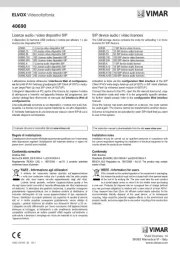
2 September 2025
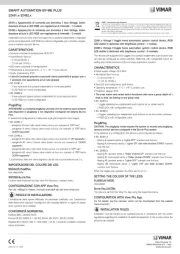
26 Augustus 2025
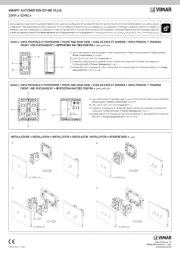
26 Augustus 2025
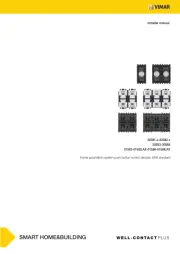
26 Augustus 2025
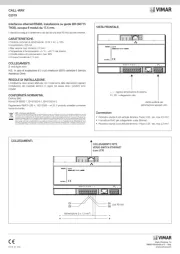
14 Augustus 2025
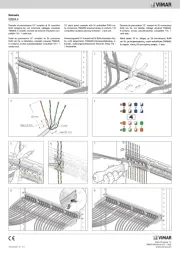
5 Juli 2025
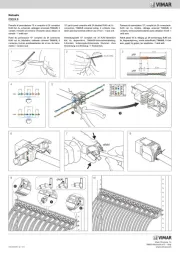
5 Juli 2025
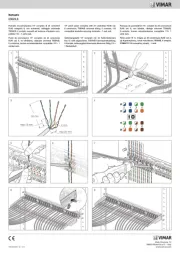
5 Juli 2025

5 Juli 2025
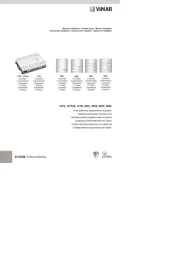
24 Mei 2025
Handleiding Niet gecategoriseerd
- Dream
- Peach
- Gator
- SleepPro
- PVI
- Dreame
- AER
- RAB
- Sonuus
- Flover
- Hillvert
- Lapp
- Dragonshock
- AMC
- Calligaris .com
Nieuwste handleidingen voor Niet gecategoriseerd

14 September 2025

14 September 2025

13 September 2025

13 September 2025

13 September 2025

13 September 2025

13 September 2025

13 September 2025

13 September 2025

13 September 2025